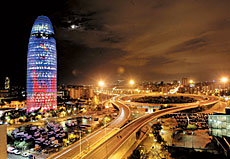Welcome to Barthelona,” a tourist hears on arrival at the airport. Get used to hearing the letter C pronounced as a soft “th” sound because you’ll hear it everywhere you go in this region. And it is a sound as soft as the warmhearted people of Barcelona are.
Many places are famous for historic sites, but Spain is famous for its blend of modern and ancient history. From Al-Andalus, or Andalusia, where signs and stories from the eighth century recall the days when the Muslims ruled the region to Barcelona where the people of Catalonia enjoy the architectural genius of Antoni Gaudí i Cornet evident throughout the city.
Guadi, who lived from 1852 to 1926, dedicated his life to art and the beautification of Barcelona. The buildings and monuments he designed created a great sense of pride among the Catalonians. During his 74 years, nine famous monuments were built among them Park Güell constructed from 1900-1914. Guadi moved his own house there while construction took place in 1906. In that time he became the most expensive and famous architect. People who view his work always come back for a second look because of its many intricacies.
Guadi captured the people’s imagination during his lifetime and after his death. He suffered from rheumatism and began observing and analyzing nature at an early age. He spent years beautifying whatever he could get his hands on until he was hit be a tram which led to he death a couple days later. The whole city mourned his passing.
Art legend Pablo Picasso also was captivated by Barcelona, and the Catalonians were captivated by his work. Originally from Malaga, Picasso adopted Barcelona as his home until his death. Tourists can still experience that magic at the Picasso Museum, which features 58 paintings Picasso donated to the museum. The galleries are arranged to mark the various periods of Picasso’s life, which the artist accentuated with stylistic changes. You can start with the Blue Period, where all the paintings were overlaid with blue-tinted colors, the Rose Period, African-influenced Period, Analytical Cubism Period and finally synthetic cubism.
In addition to beauty and art, Barcelona is a sports city where football reigns supreme. During your visit don’t forget to attend a football match and visit the world’s third largest football stadium complete with a museum dedicated to the area’s rich football heritage.
There are many restaurants offering seafood. Paella is a popular dish, and tapas is great for snacking. Other attractions include the city’s flamenco clubs with exciting stage shows and dancing and the bustling harbor with its cool breezes.
One word to the wise, dress modestly and keep you valuables secure because as a crossroads of the Mediterranean, there are thieves and pickpockets as well as a variety of con artists with sad stories looking for an easy mark to swindle. Oftentimes, interesting street performances also attract the pickpockets, so enjoy the show but remain alert. Websites recommend leaving some of your cash locked up at your hotel and asking directions only from hostellers or local officials -- essentially don’t act like a tourist, and you’ll be all right.
For those exercising a little caution, Barcelona is a wonderful destination to enjoy. If you visit once, you’re likely to return to Spain’s Catalan Coast.


